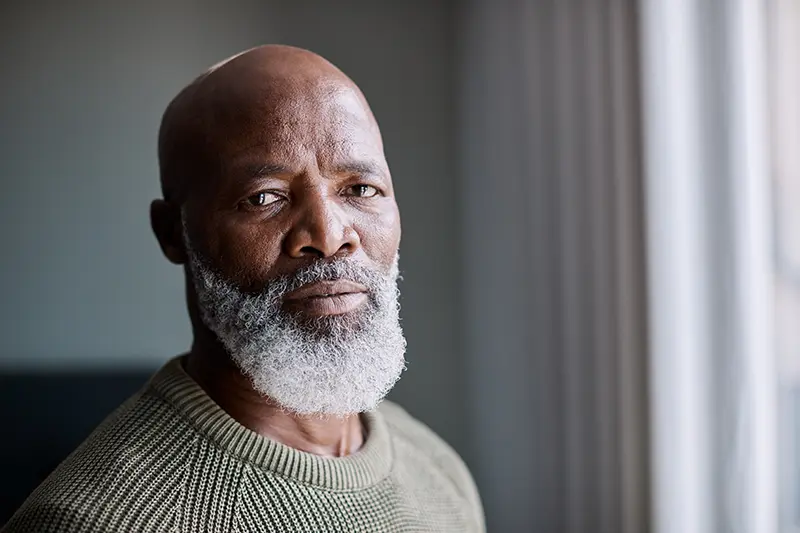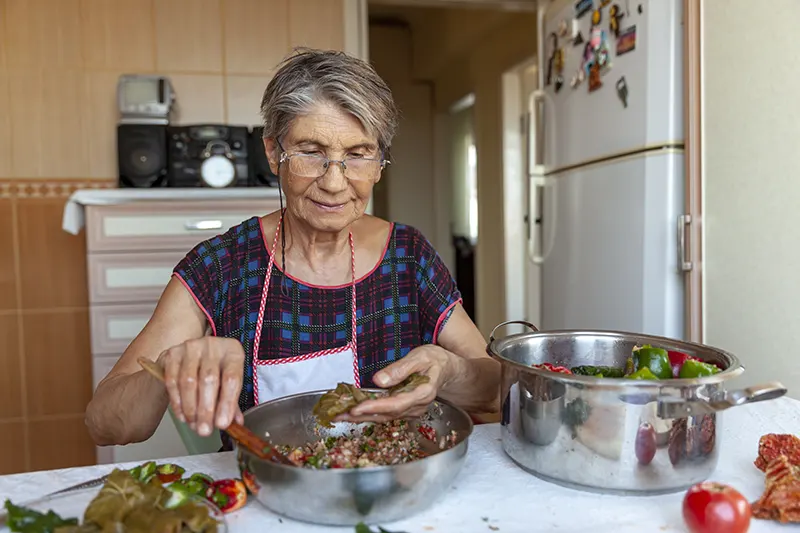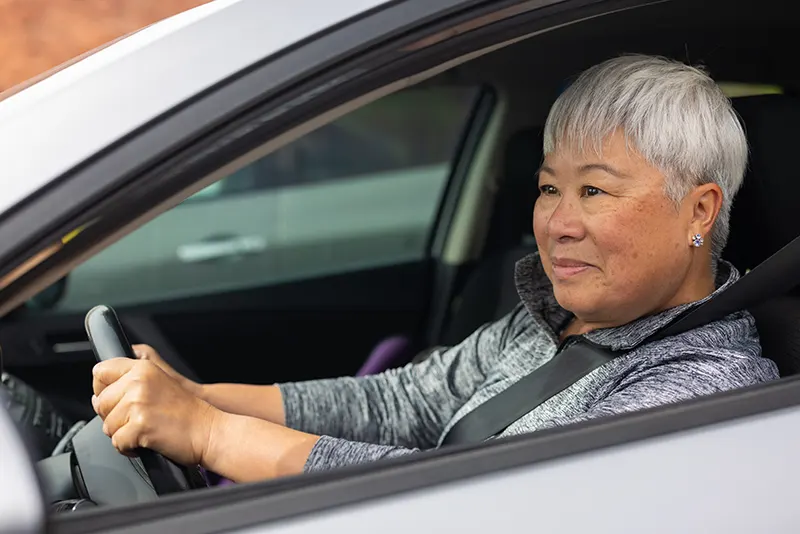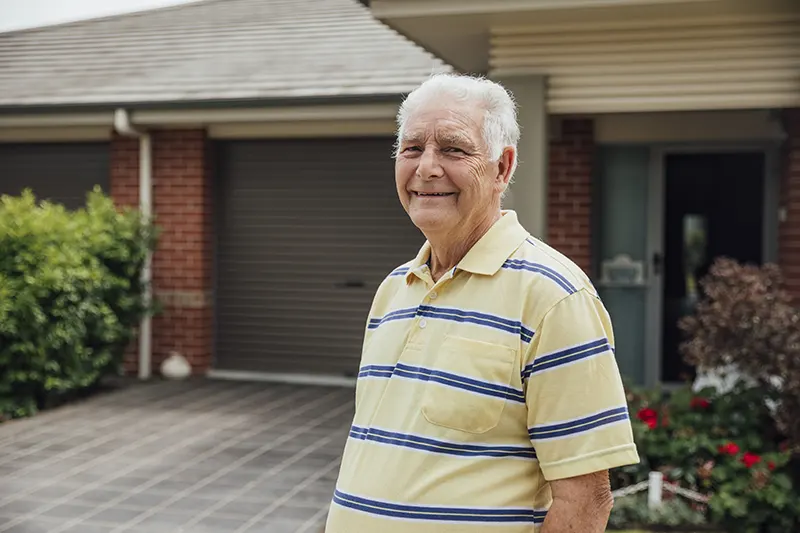Independence and Autonomy

As I get older, how am I going to be able to take care of myself and where am I going to end up living?
Male, 581
- 54% of adults ages 50-64 are extremely or very concerned about maintaining independence when thinking about getting older; 45% of adults age 65-plus share this concern
- 56% of adults ages 50-64 fear mobility loss; 58% of adults age 65-plus share this fear
- 77% of adults age 50 and older want to remain in their homes as they age
Source: Concern/Fears: Vicki Levy and Patty David, “AARP’s Second Half of Life Study, in Collaboration with National Geographic Partners and Heart+Mind Strategies,” AARP Research (June 2022). Study conducted in English. Preference to Remain in Home: Binette, Joanne, and Fanni Farago. 2021 Home and Community Preference Survey: A National Survey of Adults Age 18-Plus. Washington, DC: AARP Research, November 2021.
The concepts of independence and autonomy may mean different things to different people. Independence can mean the ability to take care of one’s daily/basic needs without the need to depend on others. It is also used in the context of independent living which describes living options such as remaining in one’s home or in residences that seek to maximize autonomy and are inclusive of home and community-based services that support activities of daily living. Autonomy can generally be defined as the “ability to make one’s own decisions, feel in control of the future, and do the things [one] wants.”2 Experiencing and sustaining a sense of autonomy can be challenging in the face of typical threats to independence (diminished ability to care for oneself, mobility issues, transportation challenges and the need to alter one’s living situation). At the same time, advocates suggest that discussions of older adults and independence or autonomy should include rich and multi-dimensional perspectives on how changing or evolving independence or autonomy over the life course relate to well-being.3 Further, linking independence with well-being is culturally specific, with collective cultures more highly valuing interdependence, or interconnection and reliance on one another, and interpreting autonomy as inclusive of having support from others.4 Topics discussed here include:
Independence is a top concern, especially through one’s 60s.
Percent very or extremely concerned about area when thinking about aging or growing older, among adults 50-plus
Caring for Self

Losing independence in self-care is a top fear among adults 50-plus.7
Many older adults fear a loss of autonomy due to diminishing capacity to take care of their basic needs. Fears could relate to personal independence, or doing things on one’s own, being “highly encouraged and advocated in American society.”8 Likely relating to their greater comfort with interdependence, Hispanic adults 50-plus are less afraid of needing someone to take care of them.
“Needing someone to take care of you” is consistently a top fear for adults 50-plus.
Percent who fear needing help with the following, among adults 50-plus
For many adults, maintaining the ability to care for oneself provides not only a sense of dignity but is also correlated with better health.
Living situations and medical contexts that encourage residents to be more independent and autonomous in terms of self-care can lead to better health and well-being outcomes for patients/residents.9,10 Studies have shown that people who are confident in their ability to perform self-care activities, and who have a sense of self-efficacy, are more likely to carry out self-care tasks, which in turn promote physical health.11
Mobility

A loss of mobility is a fear related to growing older for many adults.12
A loss of mobility has been linked to depressive symptoms in a number of studies.13
Mobility loss is among the top concerns of adults 50 and older related to aging, but becomes their very top concern by their 80s.
Percent who fear the following health problems, among adults 50-plus
Declines in mobility are associated with barriers to social participation15 and access to activities that one would like to engage in.
Importantly, issues associated with a loss of mobility are a function of structural problems created by a society that has often overlooked the needs of people of all ages and abilities. For example, because many places where people live are not accessible for those with limited mobility, a change in mobility for older adults as they age can make it difficult to create or maintain social ties (everyday social connections that have been shown to be an important driver of happiness).16
When a loss of mobility necessitates use of assistive technology, older adults can experience either an increased sense of independence or can feel stigmatized.
Adults may also be dissuaded by internalized ageism or ableism, wishing to disassociate oneself with aging or physical decline. For example, in a study that examined the use of mobility scooters, potential users view adoption with reluctance as they often associate use of assistive devices like scooters with “giving up.”19
Driving

Linked to a fear of losing mobility, independence, and autonomy, many older adults are conscious of the challenges that losing their ability to drive (chosen or forced) might bring.
Advocates of livable communities suggest that a change in driving status might not be as significant of a fear if societies and infrastructure were better developed, whereas currently the ability to drive can be highly impactful in one’s ability to fully participate in society.
“Not being able to drive” is a fear that increases with age and remains significant through age 80-plus.
Percent who fear needing help with the following, among adults 50-plus
For older adults, driving cessation has been related to depression.
A meta-analysis of five studies looking at the correlation between “driving cessation and depression revealed that driving cessation almost doubled the risk of depressive symptoms in older adults.”20
Nine in ten adults age 50-plus drive themselves to get around their communities, and a large majority want community features that support drivers.
Many adults 50-plus also see value in having a special transportation service for older residents and/or residents with disabilities (37%) and a taxi or ride-share service (22%).21
Home & Home Modifications

Adults age 50-plus overwhelmingly want to stay in their homes, with most preferring to do so independently.
However, older adults are more likely to see the need for support systems with age. Women are also more likely than men to express the desire for and expectation of support from others.
Older adults overwhelmingly want to remain in their homes while also being more likely to see the need for support systems with age.
Where people want to live as they grow older, among adults 50-plus
Expectation of living independently, in their own home, decreases with age.
Where people believe they will live as they grow older, among adults 50-plus
While most prefer remaining in their homes, many adults would consider leaving their current home to find one that would better enable them to age independently.
This is true for over half of adults age 50-plus (all adults: 49%; 50-plus: 57%).22
One-third of adults age 50-plus say they need to make modifications to their current residence so that they or a loved one could continue living there in the event they needed physical assistance.23
However, many adults do not consider modifying their home until a medical event occurs (such as a fall), and thus home modifications tend to occur too late rather than proactively. Even as most of the nation’s housing stock is not accessible, barriers to modification remain including cost barriers and zoning issues outside the interior of the home that can make modifications more difficult.24,25,26
Top four home modifications adults 50-plus need to continue living at their current residence, with bathroom modifications needed by most adults who expect to make changes.
Percent who need modifications to continue living at their current residence, among adults 50-plus who expect to make changes
Key Takeaways
-
Half of adults 50-plus are worried about maintaining independence and needing someone to take care of them. American culture emphasizes independence, which can contribute to fear associated with losing independence with age.
-
Older adults overwhelmingly want to remain in their homes as they age. Assistive technology and home modifications can be empowering, but may come with stigma. Ableism and ageism can make older adults reluctant or reactive in taking these measures.
-
Greater accessibility throughout society would help older adults adapt to mobility changes. Structural issues with accessibility, including car-dependent infrastructure, can make it difficult for those who lose mobility or the ability to drive to maintain independence and connections.
See also:
For more information related to independence and autonomy, see:
- The Lived Experience of Adults 50-plus: Interdependence
- The Lived Experience of Adults 50-plus: Brain and Body Health
- The People Say : Transportation Access and Housing Access and Suitability
Sources
- Feedback Loop Research, AARP, June 2023.
- Sergio Sánchez-García, Carmen García-Peña, Eliseo Ramírez-García, Karla Moreno-Tamayo & Guillermo Rafael Cantú-Quintanilla, “Decreased Autonomy in Community-Dwelling Older Adults,” Clinical Interventions in Aging, 14 (2019): 2041-2053, 10.2147/CIA.S225479.
- Sophie Mitra, Debra L. Brucker, and Katie M. Jajtner, “Wellbeing at Older Ages: Towards an Inclusive and Multidimensional Measure,” Disability and Health Journal, 13, no. 4 (2020): 100926.
- Liu, Lili, Christine Daum, Antonio Augusto, Noelannah Neubauer, Hector Perez-Meana, and Adriana Maria. 2022. “Ageing, Technology, and Health: Advancing the Concepts of Autonomy and Independence” Healthcare Management Forum 35 (5): 296–300.
- Liu, Lili, Christine Daum, Antonio Augusto, Noelannah Neubauer, Hector Perez-Meana, and Adriana Maria. 2022. “Ageing, Technology, and Health: Advancing the Concepts of Autonomy and Independence” Healthcare Management Forum 35 (5): 296–300.
- D. Moza, S. I. Lawrie, L.P. Maricuțoiu, A. Gavreliuc, and H.S. Kim, “Not All Forms of Independence Are Created Equal: Only Being Independent the ‘Right Way’ Is Associated With Self-Esteem and Life Satisfaction” Frontiers in Psychology, 11 (2021): 606354.
- Vicki Levy and Patty David, “AARP’s Second Half of Life Study, in Collaboration with National Geographic Partners and Heart+Mind Strategies,” AARP Research (June 2022). Study conducted in English.
- PF Edemekong, DL Bomgaars, S Sukumaran, et al. “Activities of Daily Living,” June 26, 2023, StatPearls Publishing.
- Maryanne Sacco-Peterson and Lena Borell, “Struggles For Autonomy in Self-care: The Impact of the Physical and Socio-cultural Environment in a Long-term Care Setting,” 07 December 2004.
- C. Rodrigues, D. Mendonça, and M.M. Martins, “Basic Self-care in Older Acute Medical In-patients: A Retrospective Cohort Study,” Porto Biomedical Journal, 3, no. 1 (2018).
- D. Fu, H. Fu, P. McGowan, YE Shen, L Zhu, H Yang, et al. “Implementation and quantitative evaluation of chronic disease self-management programme in Shanghai, China: randomized controlled trial,” Bull World Health Organ, 81: 74–82 (2003).
- Levy and David, AARP’s Second Half of Life Study.
- P Lampinen, E. Heikkinen, “Reduced Mobility and Physical Activity as Predictors of Depressive Symptoms Among Community-dwelling Older Adults: An Eight-year Follow-up Study,” Aging Clin Exp Res. 15, no. 3: 205-11. doi: 10.1007/BF03324501. PMID: 14582683.
- Molly Wigand, and Linda J. Keilman, “Maintaining Mental Health Through Mobility Loss,” Forbes, (August 31, 2023).
- A.L. Rosso, J. A. Taylor, L.P. Tabb, and Y.L. Michael, “Mobility, Disability, and Social Engagement in Older Adults,” Journal of Aging and Health, 25, no. 4 (2023): 617–637.
- Gillian M. Sandstrom and Elizabeth W. Dunn, “Social Interactions and Well-Being: The Surprising Power of Weak Ties,” Personality and Social Psychology Bulletin, (2014).
- Smith, Leah. 2023. “#Ableism – Center for Disability Rights.” 2023. https://cdrnys.org/blog/uncategorized/ableism/.
- Mariska van der Horst, lecturer at the VU Amsterdam, Centre of Ageing Better, When ageism is really ableism.
- R. Thoreau, “Perception of needing and using a mobility scooter: a preclinically disabled non-scooter user perspective,” Disabil Rehabil Assist Technol, 14, no. 7: 732-736 (October, 2019), doi: 10.1080/17483107.2018.1499136. Epub 2018 Jul 25. PMID: 30044686.
- S Chihuri, TJ Mielenz, CJ DiMaggio, ME Betz, C DiGuiseppi, VC Jones, G Li, “Driving Cessation and Health Outcomes in Older Adults” J Am Geriatr Soc., 64, no. 2: 332-41 (February 2016), doi: 10.1111/jgs.13931. Epub 2016 Jan 19. PMID: 26780879; PMCID: PMC5021147.
- Joanne Binette and Fanni Farago, AARP Research, “Where We Live, Where We Age, Trends in Home and Community Preferences,” (2021).
- Binette and Farago, Where We Live, Where We Age, Trends in Home and Community Preferences.
- Binette and Farago, Where We Live, Where We Age, Trends in Home and Community Preferences.
- “Home Modifications Aging in Place Remodeling.” American Society on Aging. 2020.
- Jennifer Molinsky, “Housing For America’s Older Adults: Four Problems We Must Address,” Joint Center for Housing Studies of Harvard University. (August 18, 2022).
- “Falls and Fractures in Older Adults: Causes and Prevention.” 2022. National Institute on Aging. Accessed November 16, 2023.